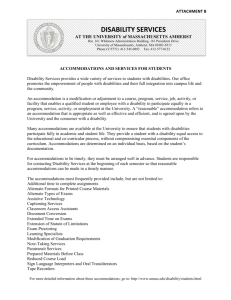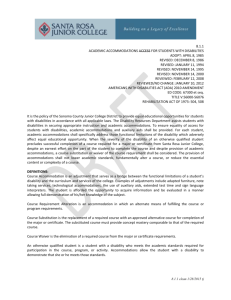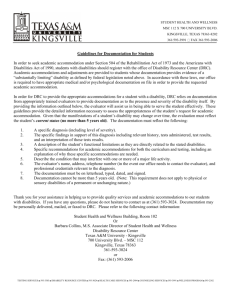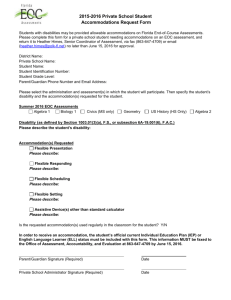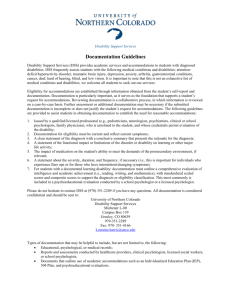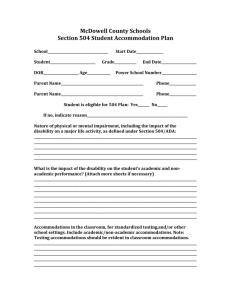Students with Disabilities
advertisement
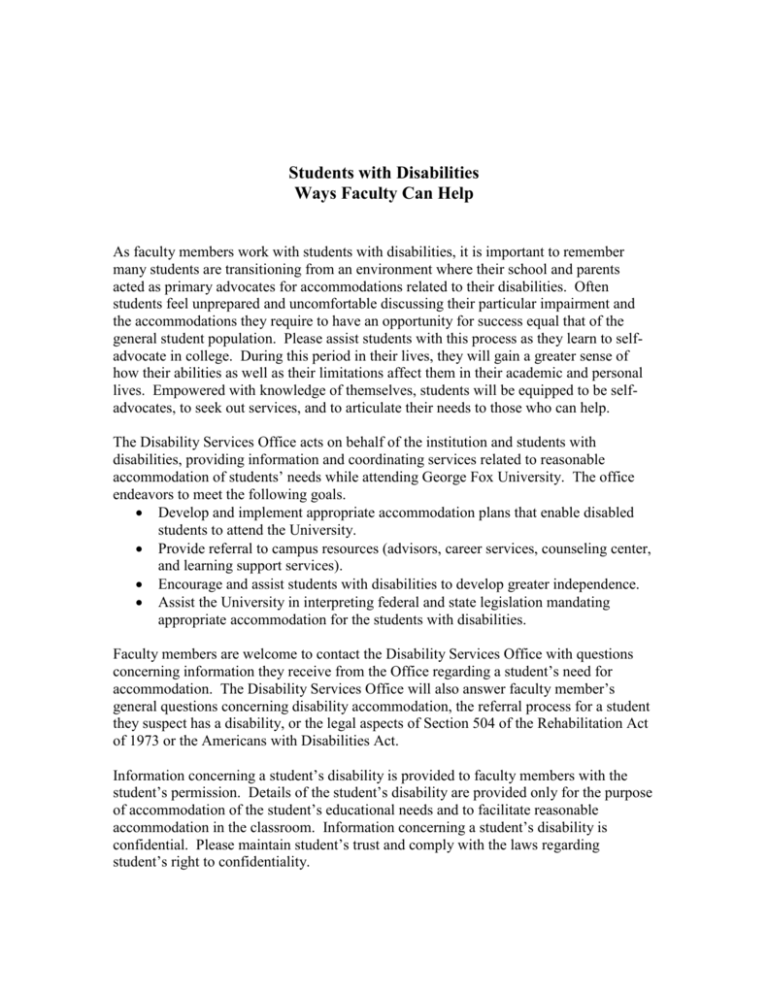
Students with Disabilities Ways Faculty Can Help As faculty members work with students with disabilities, it is important to remember many students are transitioning from an environment where their school and parents acted as primary advocates for accommodations related to their disabilities. Often students feel unprepared and uncomfortable discussing their particular impairment and the accommodations they require to have an opportunity for success equal that of the general student population. Please assist students with this process as they learn to selfadvocate in college. During this period in their lives, they will gain a greater sense of how their abilities as well as their limitations affect them in their academic and personal lives. Empowered with knowledge of themselves, students will be equipped to be selfadvocates, to seek out services, and to articulate their needs to those who can help. The Disability Services Office acts on behalf of the institution and students with disabilities, providing information and coordinating services related to reasonable accommodation of students’ needs while attending George Fox University. The office endeavors to meet the following goals. Develop and implement appropriate accommodation plans that enable disabled students to attend the University. Provide referral to campus resources (advisors, career services, counseling center, and learning support services). Encourage and assist students with disabilities to develop greater independence. Assist the University in interpreting federal and state legislation mandating appropriate accommodation for the students with disabilities. Faculty members are welcome to contact the Disability Services Office with questions concerning information they receive from the Office regarding a student’s need for accommodation. The Disability Services Office will also answer faculty member’s general questions concerning disability accommodation, the referral process for a student they suspect has a disability, or the legal aspects of Section 504 of the Rehabilitation Act of 1973 or the Americans with Disabilities Act. Information concerning a student’s disability is provided to faculty members with the student’s permission. Details of the student’s disability are provided only for the purpose of accommodation of the student’s educational needs and to facilitate reasonable accommodation in the classroom. Information concerning a student’s disability is confidential. Please maintain student’s trust and comply with the laws regarding student’s right to confidentiality. Students’ rights and responsibilities Rights Nondiscrimination, meaningful access Individualized assessments Effective academic adjustments Confidentiality Responsibilities Request “reasonable” modification Meet eligibility standards for qualified status Provide documentation Provide necessary information Section 504 of the Rehabilitation Act of 1973 mandates accommodations in academic programs that provide qualified students equal opportunity to achieve success in college. The legal requirement to provide accommodations does not require alteration in the essential or fundamental curriculum of core importance to the major. However, the student must be accommodated in a manner that provides him/her meaningful access and opportunity to succeed in spite of his/her disability. Faculty can help with two basic types of accommodation: 1. Those that relate to teaching methods, i.e., the way faculty provide information. 2. Those that relate to evaluation methods, i.e., the way faculty measure a student’s mastery. STUDENTS WITH LEARNING DISABILITIES Suggested teaching accommodations. 1. Make the syllabus available four to six weeks before the beginning of the semester, and when possible, be available to discuss the syllabus with students considering taking the course. 2. Notice and respond to non-verbal signals of confusion or frustration. 3. Try to eliminate or at least diminish auditory and visual classroom distractions such as noise in the hallway or a flickering fluorescent light. 4. Give assignments in writing as well as orally and be available for clarification. 5. Be available during office hours for clarification of lecture material, assignments, and readings. 6. Select a textbook with a study guide, if available, offer question and answer sessions, review sessions, and quiz sessions. 7. Help students find study partners and organize study groups. 8. Provide study questions for exams that demonstrate the format that will be used as well as the content. Provide a model exemplary answer and delineate what comprises a good response. 9. Ask the student who self-discloses his/her disability how you as the instructor can facilitate his/her learning. 10. Discuss in private with the student that you suspect may have a learning disability, describe what you have observed, and if appropriate, refer the student to the Disability Services Office. Note: Students with learning disabilities often have difficulty reading aloud in spite of good silent reading comprehension. Calling only on students who volunteer to read aloud will avoid unnecessary embarrassment. Suggested testing/evaluation accommodations The specific testing and/or evaluation accommodations provided must be determined on an individual basis after considering the student’s type and severity of learning disability, the course content, and course objectives. Suggested accommodations follow: 1. Allow extended time on exams. 2. Provide a reader or a tape recorded exam when the exam entails a significant amount of reading (e.g., a multiple choice exam). 3. Provide the exam in an alternate format (if appropriate to subject matter, e.g., objective instead of essay or vice versa). 4. Allow students to take exams in a separate room that is a distraction-free environment. 5. Allow students to answer exam questions using methods other than writing, for example, orally, taping, or typing. 6. Allow students to clarify or rephrase an exam question in their own words as a comprehension check before answering the question. 7. Analyze whenever appropriate (e.g., in solving math, chemistry, or physics problems), not only the final solution, but also the process the student used to reach the solution. 8. Allow alternative methods to demonstrate mastery of course objectives (e.g., a research project, oral presentation or a paper). 9. Allow students to use computational aids, such as a calculator, and spelling aids such as a secretary’s desk reference, spell checker on a word processor or the misspeller’s dictionary. 10. Avoid unduly complex sentence structure, such as double negatives and embedding questions within questions. 11. Provide ample blank space or additional exam booklets for students with overly large handwriting. 12. Permit student with illegible handwriting to use a laptop computer. 13. Provide alternatives to computer-scored answer sheets such as allowing students to indicate their answers directly on the examination. 14. Ignore spelling errors in determining the grade when work is done in class without spelling aids, and correct spelling is not the objective of the course. Hearing impairments 1. Use good diction. 2. Describe clearly what is being written on the board. 3. Avoid using pronouns such as “this” and “that”. 4. Give full descriptions, mentioning colors and amounts and giving as many details as possible. 5. Keep the room arrangement consistent. 6. Keep the classroom door closed to limit noises that might filter from the hallways and other classrooms. 7. Write in larger and darker print on the whiteboard. Mobility and manual impairment 1. Make sure the classroom/lab is arranged to accommodate the student’s mobility needs. 2. Allow an assistant to accompany and support the student with in-class activities (e.g., lab experiments, taking notes, acting as scribe, etc.) 3. Make test accommodations. Speech and language impairments 1. Meet with student prior to the beginning of the course to determine communication accommodations. 2. Permit course substitutions for nonessential courses (e.g., foreign languages, or public speaking). 3. Make accommodations for oral presentations, if necessary. 4. Set a tone of acceptance and patience in the classroom. 5. Encourage self-expression. 6. Encourage acceptance from other students. 7. Be honest with the student if you cannot understand their speech. Psychiatric disabilities 1. Make test accommodations such as extended time and a quiet room for taking exams. 2. Show patience and understanding. Medical disabilities 1. Make accommodations for class absences when student misses class for medical treatment. 2. Make test accommodations such as extended time and a quiet room for taking exams. 3. Accommodate need for extra time to complete coursework.
